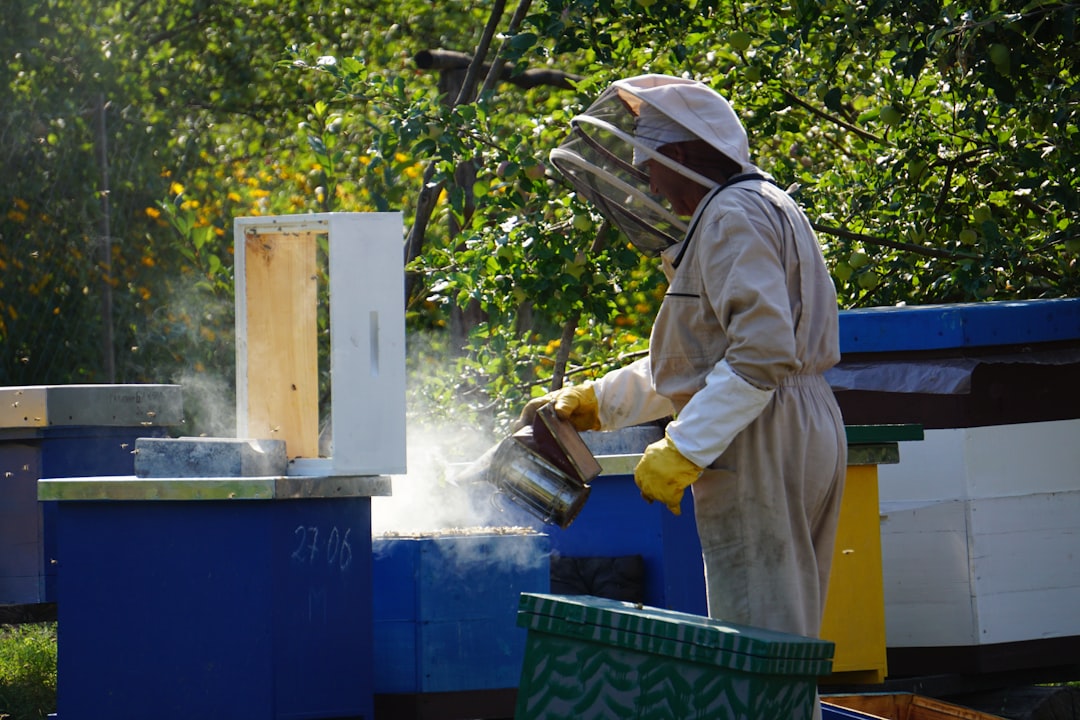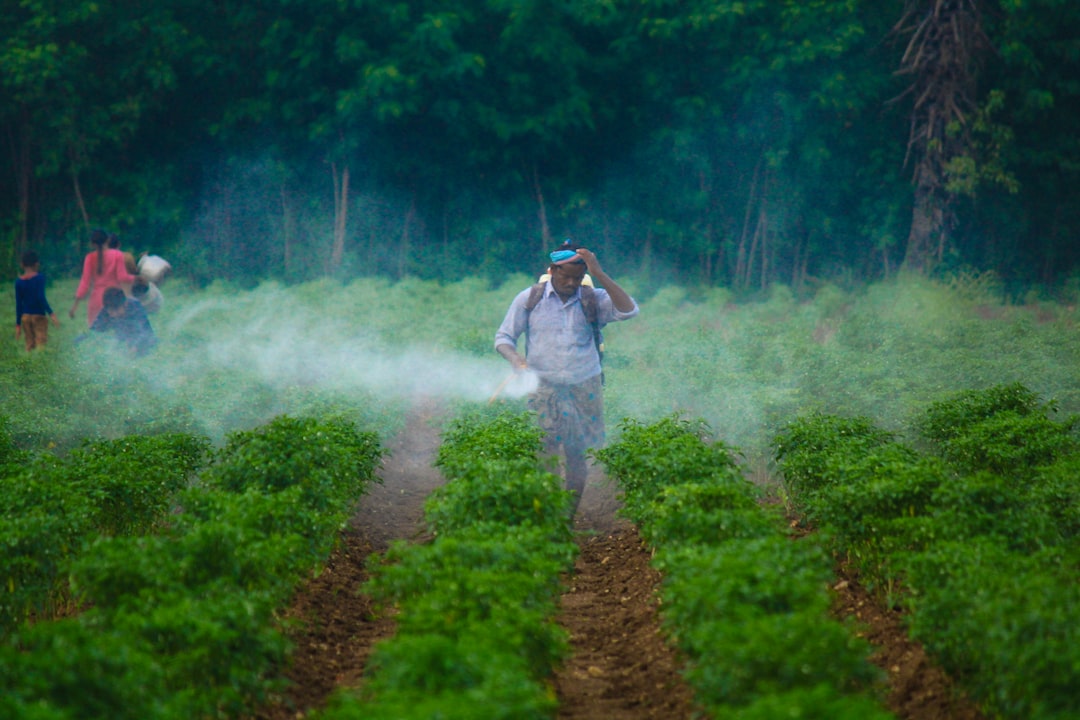

Engage prospects with a scan and streamline customer engagement with FREE QR code marketing tools by Sona – no strings attached!
Create a Free QR CodeFree consultation

No commitment

Engage prospects with a scan and streamline customer engagement with FREE QR code marketing tools by Sona – no strings attached!
Create a Free QR CodeFree consultation

No commitment
The agricultural sector faces constant pressure to ensure both regulatory compliance and worker safety, especially when handling and applying pesticides. Pesticide safety training programs are vital for protecting worker health, maintaining food safety standards, and reducing workplace incidents. Traditional approaches such as paper handbooks, static signage, and in-person lectures often fall short in providing timely, accessible, and trackable training that matches evolving requirements.
As businesses shift toward connected, data-driven workflows, QR codes have become a practical tool to fill gaps left by outdated systems. By linking on-farm situations to digital training resources, QR codes help convert previously untracked engagement, such as a worker reading a chemical label, into meaningful data and actionable follow-up. Whether providing instant access to up-to-date pesticide information, real-time compliance checks, or multilingual safety videos, QR integration removes common barriers to participation and tracking.
With QR technology, agricultural organizations can meet compliance mandates while empowering workers with instant access to education, no separate app or infrastructure required. This increases the chances of capturing every high-value training opportunity, including those who might otherwise remain unidentified in disconnected paper systems. The result is higher engagement and retention rates, improved regulatory reporting, and stronger incident prevention.

Compliance in pesticide safety often fails at the point of access. Training materials sit in binders, signage is overlooked, and attendance sheets disappear. QR codes solve these access and tracking gaps by making each physical moment, such as opening a storage cabinet or prepping a spray rig, a trigger for digital content and recordkeeping. When every scan routes a worker to the right resource, in the right language, with instant acknowledgment, training turns from a static requirement into a continuous learning loop.
To drive both compliance and engagement, align QR deployments with real workflows. The goal is to bring the training to the worker at the exact moment of need. This reduces friction, strengthens retention, and creates verifiable data. When paired with a centralized dashboard such as Sona QR, managers can update content without reprinting materials and export audit-ready reports on demand.
These steps help close the loop between training, verification, and action. They address missed compliance signals, unknown engagement levels, and untracked completions, building a culture where safety learning is documented and continuously improved.

Agricultural operations contend with complex regulations, seasonal labor, language diversity, and dispersed worksites. The major barrier to effective pesticide safety learning is not intent, it is access. Training must be available during real tasks and it must be updated as labels, policies, and seasons shift. QR codes for agricultural marketing meet these requirements by making learning instant, context-aware, and measurable.
When every label, poster, and equipment tag becomes an on-ramp to training, the program stops relying on memory or manual compliance logs. Supervisors no longer wait for audits to uncover gaps. Instead, real-time scan data reveals who engaged with what content and where additional coaching is required. In short, QR codes turn invisible learning moments into a documented chain of custody for safety.
With these advantages, QR codes reduce incident risk while improving participation and accountability across dispersed agricultural operations.
Not all QR codes serve the same purpose. By selecting formats that match your training goals, you ensure that each scan drives a specific action, such as viewing a video, signing a form, or contacting a supervisor. The right format also determines what data you collect and how quickly you can adapt content as regulations change.
Dynamic QR codes are particularly valuable in pesticide safety. They allow you to modify destinations, languages, and modules without reprinting physical materials. A platform like Sona QR makes it easy to manage these variations, apply tags and UTM parameters, and centralize reporting.
Pair each format with destinations that reinforce a single clear action. For example, storage-room signage might link directly to an MSDS library, while onboarding packets route to a form that records course completion.

The most effective QR campaigns meet workers at high-impact moments. Mapping the physical journey across a farm or processing facility reveals where training can be reinforced and measured. By placing QR codes at these points, you reduce the distance between intent and action and create consistent data logs that prove compliance.
Look for locations where risk is highest or where tasks frequently occur under time pressure. In those contexts, short and focused content is more likely to be consumed. Use clear calls to action, such as “Scan for PPE checklist” or “Scan to confirm mixing protocol,” and ensure codes are accessible at common eye level with adequate lighting.
This placement strategy improves visibility and makes training an ongoing habit rather than a one-time event. It also yields reliable participation data tied to real work contexts.

QR codes turn typical training friction points into streamlined digital experiences. The following use cases are proven to reduce effort for workers and supervisors, while making compliance more transparent. Tailor each case to your staffing structure, languages, and regulatory requirements.
By standardizing these use cases across sites and teams, you also create a repeatable process that survives turnover and seasonal shifts. With a platform such as Sona QR, you can clone campaigns, localize content, and track performance by location, crew, or vendor.
These use cases transform training from a compliance obligation into an ongoing, data-driven program. Over time, the cumulative effect is fewer incidents, faster audits, and higher confidence across management and regulatory agencies.
Each scan is a signal triggered in a specific context: location, time, language, and topic. When you assign unique QR codes to different modules, teams, or sites, you naturally segment your audience. This enables targeted follow-ups that respect the worker’s role and immediate needs rather than blasting generic reminders.
Retargeting in agricultural safety looks different from consumer marketing. The goal is not to sell a product, it is to nudge completion, reinforce behaviors, and close compliance gaps. Use your QR data to reach the right people with the right message at the right time. See the retargeting playbook for tactics.
With Sona QR, each code becomes a smart entry point into your funnel of safety communications. Segmentation ensures outreach is respectful, relevant, and likely to drive the next action.
Pesticide safety training is a communication challenge as much as an instructional one. Workers encounter messages in print, on equipment, in texts, and at meetings. QR codes connect these channels so each touchpoint propels the worker to a clear digital action, while centralizing performance data.
A unified approach helps managers allocate resources to the channels that perform best. It also reduces confusion by aligning messages and ensuring that updates propagate quickly across materials. The result is a consistent experience where every route leads to a clear, measurable action.
QR codes serve as connectors that unify your offline and digital training ecosystem. Platforms like Sona QR provide a single source of truth for code management and analytics, so you can track which channels work best and optimize in real time.
A well-run QR campaign replaces manual, error-prone compliance cycles with timely communications and verifiable data. The following steps outline a repeatable approach that scales across locations and seasons. Start small if needed, then expand to additional modules and languages once the process is established.
Before launch, align with supervisors and safety officers so expectations are clear. Agree on the metrics that define success, such as completion rates, incident reductions, or faster audit preparation. Keep the worker experience central to every decision.
Define one primary goal, such as verifying annual Worker Protection Standard training, rolling out a new restricted-use pesticide label, or reducing mixing errors. Focus ensures the code’s call to action is simple and compelling. Clarify what action will count as success, such as a digital acknowledgment, quiz completion, or certificate verification.
Map the physical locations where this training is most relevant. If the objective is a new label rollout, place codes on storage racks and mixing stations. If it is PPE compliance, focus on locker rooms and equipment sheds. Align deployment with actual workflows to maximize scans.
Choose dynamic QR codes for any campaign that requires tracking, updates, or segmentation. Dynamic codes allow you to change destinations without reprinting, apply UTM parameters, and log scan metadata by location and device. Static codes are suitable for fixed resources such as a general safety homepage or a one-time PDF.
Confirm privacy and security needs. If the destination requires identity confirmation, link to an authenticated portal or include a simple form. With Sona QR, you can configure code-level settings, add tags, and connect scans to specific teams or modules. Start creating QR codes for free.
Use clear visual framing, short benefit-driven calls to action, and adequate contrast. Add a simple instruction such as “Scan for PPE checklist” or “Scan to verify training.” Keep the code size large enough for typical scan distance, and print on durable materials that withstand moisture and UV exposure common in agricultural settings.
Test with multiple devices and under real lighting conditions. Angle the code to reduce glare near stainless work surfaces, and place copies at multiple heights to serve workers of different statures. Confirm that the destination page loads quickly on rural networks and is accessible in multiple languages.
Launch codes where engagement risk is highest. Prioritize mixing areas, equipment, and breakrooms. Place backup codes in supervisor vehicles and on laminated cards for field leads. In onboarding packets, include a code that routes to a checklist of all required trainings, so new hires can progress with minimal supervision.
Brief supervisors on how to promote scanning during daily huddles. Demonstrate exactly what workers will see when they scan, and explain the benefit, such as faster pay approvals tied to completed training. Visibility plus context creates trust and increases participation.
Monitor scan volume, completion rates, and quiz scores in real time. Identify which locations and shifts lag behind, then adjust signage, language, or timing. A/B test CTAs and landing page designs to improve conversions. As patterns emerge, standardize what works and roll it out across additional sites.
Close the loop with reporting. Export summaries for audits, share progress with leadership, and recognize teams that reach milestones. Use these insights to plan the next campaign, building a continuous improvement cycle for safety and compliance.
Measuring training participation only by headcount misses critical insight. You need to know who scanned, what they viewed, whether they completed the module, and how behavior changed in the field. QR analytics provide that granularity, connecting training touches with downstream outcomes such as fewer incidents, less downtime, and improved inspection scores.
A modern analytics stack turns every scan into a data point you can act on. With Sona QR, you can track scans by time, device, and location, segment by team or language, and sync results with HR or learning systems. With Sona.com, you can go further by connecting QR engagement to broader operational metrics, creating a holistic picture of impact.
This analytics approach elevates safety training from a box-checking exercise to a performance driver. It equips leaders with the data needed to allocate resources, support at-risk teams, and demonstrate ROI.
Scaling QR deployment across multiple farms, facilities, and crews requires consistency and creativity. Standardize what works, then adapt for local nuances like language mix, shift schedules, and network coverage. Keep the worker experience central: short modules, clear benefits, and visible calls to action always outperform complex flows.
Consider where workers spend idle moments, such as waiting for a load or in a break area. These are perfect times for microlearning delivered by QR codes. Make it easy to continue a partially completed module later, and always thank workers for engaging to reinforce positive behavior.
These practices reduce drop-off and increase visibility. Over time, they build a culture of consistent, trackable learning that strengthens both safety and compliance.

Organizations moving from manual logbooks to QR-based engagement report significant gains. One orchard operation placed QR codes on storage racks and badges. Completion rates for annual pesticide safety training rose by approximately 40 percent, and audits were streamlined with instant access to time-stamped records. Supervisors spent less time chasing signatures and more time coaching.
Another grower used multilingual QR posters in break areas and near water stations. Workers scanned for short videos on heat illness prevention, PPE, and mixing safety in their preferred language. Over the season, incident reports related to improper handling dropped by roughly 25 percent. In addition, feedback forms delivered via QR helped the safety team identify confusing labels that required clearer guidance.
Food processors have used QR-linked incident reporting to accelerate response times. By scanning a code at the nearest workstation, employees can pre-fill key details, attach photos, and alert the right manager. This immediacy improves regulatory trust and demonstrates a proactive safety culture.
These examples illustrate a common pattern. When a scan becomes the first step in every training, verification, or reporting flow, the organization gains visibility and control. The resulting data informs future training, guides resource allocation, and supports continuous improvement.
Even small missteps can slow adoption. Codes placed too low, too small, or without a clear benefit are often ignored. To succeed, design for the environment, explain the value, and test thoroughly under real conditions. Treat every scan as a promise: a quick, relevant, and helpful experience.
Engage supervisors early. Their support determines whether QR codes become part of daily routines or remain a novelty. Provide them with talking points, simple scripts for tailgate meetings, and mobile-ready dashboards so they can monitor progress in the field.
With these practices, QR code campaigns move from checkbox compliance to a trusted system that improves safety outcomes and operational efficiency.
QR codes are revolutionizing pesticide safety training for agricultural organizations, delivering faster, more accessible, and easily measurable programs. Each scan unlocks visibility and actionable data, ensuring no training opportunity is missed due to inefficiency or anonymity. Embedding QR touchpoints across facilities, equipment, and materials allows leaders to unify compliance and engagement, even as regulatory and workplace needs evolve.
Implementing QR-powered learning transforms fragmented or uncertain compliance into ongoing, data-driven improvement. The payoff is higher participation, fewer incidents, and smoother audits, supported by a continuous loop of measurement and optimization. By starting with high-impact placements and dynamic content management through tools like Sona QR, any operation can accelerate its journey toward safer, smarter, and fully compliant pesticide practices.
QR codes have revolutionized pesticide safety training programs by transforming traditional compliance efforts into dynamic, interactive learning experiences. They streamline access to vital training materials, track participant engagement in real time, and ensure up-to-date information is always at hand—eliminating paperwork and boosting regulatory adherence. Imagine instantly knowing which training modules resonate most with your team and being able to update safety protocols on the fly without costly reprints.
With Sona QR, creating dynamic, trackable QR codes tailored to pesticide safety is effortless. You can monitor scans to verify training completion, adjust content instantly to meet evolving regulations, and connect every interaction directly to compliance outcomes. No more guesswork, just a smarter, more effective approach to safety training.
Start for free with Sona QR today and turn every scan into a verified step toward safer operations and full regulatory compliance.
Key components include up-to-date training materials, accessible and trackable delivery methods, multilingual content, microlearning modules on PPE and emergency response, digital acknowledgements, and ongoing engagement linked to real work tasks.
QR codes provide instant access to digital training resources at the point of need, enable real-time tracking and compliance verification, support multilingual microlearning, allow dynamic content updates, and convert informal learning moments into documented data.
Legal requirements mandate regular and verifiable pesticide safety training that protects worker health and complies with regulations, including updated information on labels and policies, which QR code programs help meet by ensuring timely access and documentation.
Resources can be accessed via QR codes placed strategically on chemical storage, equipment, onboarding packets, and signage, which link to up-to-date safety videos, standard operating procedures, multilingual manuals, and microlearning modules.
Best practices include following updated label instructions, using proper PPE, observing re-entry intervals, preventing drift, and accessing just-in-time training and safety checklists through QR codes placed at chemical mixing zones and equipment.
Develop the program by mapping key risk locations, deploying QR codes for instant access to relevant training content, delivering short microlearning modules, digitizing acknowledgements, tracking engagement centrally, and continuously optimizing based on data.
Benefits include immediate access to current safety data, improved training participation, multilingual support, real-time compliance tracking, reduced paperwork, dynamic content updates without reprinting, and verifiable audit-ready records.
Ensure proper training by integrating QR codes at high-impact work points, providing clear calls to action, delivering short and language-specific modules, digitizing confirmations, monitoring scan data to identify gaps, and involving supervisors to promote scanning.
Consequences include increased risk of worker health incidents, regulatory non-compliance, workplace accidents, food safety breaches, audit failures, and potential legal and financial penalties.
Use Sona QR's trackable codes to improve customer acquisition and engagement today.
Create Your FREE Trackable QR Code in SecondsJoin results-focused teams combining Sona Platform automation with advanced Google Ads strategies to scale lead generation

Connect your existing CRM

Free Account Enrichment

No setup fees
No commitment required

Free consultation

Get a custom Google Ads roadmap for your business






Launch campaigns that generate qualified leads in 30 days or less.
